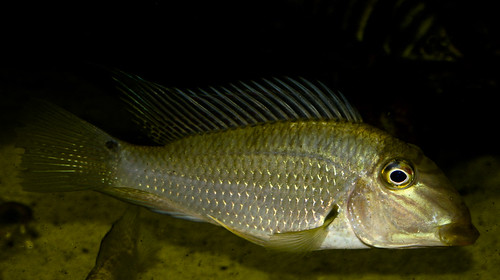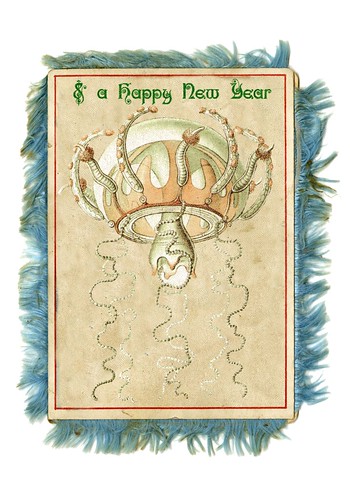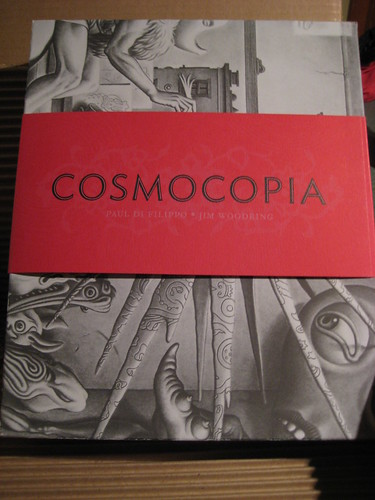I don’t read Tropical Fish Hobbyist regularly, but every so often (maybe once a year) it will catch my eye on the newsstand with interesting teasers and I grab a copy. October ’08 was such an issue – the cover had a picture of half of one of my favorite marine duos – shrimp gobies and the shrimp that cohabit with them. That was enough to get me to leaf through – I saw an article on Betta macrostoma – sold!
Neither the shrimp/goby duo nor the betta are the subject of this post, though. One of the columnists, Wayne Leibel, hit one out of the park with his article on the etymology of the Latin name for one of the eartheater cichlids. A bit of background info for those who aren’t familiar with them: cichlids are cosmopolitan small to medium sized (mostly) freshwater perch-like fish that display an incredible range of morphological and behavioral adaptations. Interesting critters! The name he explicated – Satanoperca jurupari. Luckily, there’s a version of the article online, so I can quote extensively and link back.
Both the genus and the species name refer to the supernatural. Satanoperca = Satan’s perch; jurupari/yurupari is the Tupi name for a forest demon. What’s the link between the forest demon and a creature of the river?
I have always (at least since I first read that the name “Jurupari” had demonic associations) been obsessed with clearing up that etymological association and have always felt gypped by Heckel (and Natterer for that matter) for not having shared the entire story with us. Why was this fish called “juruparipindi?” Despite consultation with a variety of South American ethnographies and compulsive index checking of any and every book having to do with Amazonian exploration, I have never found a satisfactory answer, although Mr. Robinson’s contribution came the closest.
Well, I think I have finally stumbled across the full association. While browsing in a college bookstore the other week, I noticed — in the Anthropology/Sociology section — two books entitled, respectively, Mythology of North America and Mythology of Mexico and Central America by John Bierhorst. Upon further inspection, the fly leaves provided the information that this same author had written a companion — and earlier — volume entitled (you guessed it!) Mythology of South America (1988, Quill/William Morrow Co., New York, 270 pp.). Well, I thought just maybe he’d have the answer, so gambling $10, I special ordered it.
When it came, I paged quickly to the index and looked up Jurupari — nothing! Frantically, I paged to the alternate spelling and found seven pages devoted to “Yurupari,” mythological character! What Bierhorst had done in these books was to collect myths that pop up time and time again throughout the native tribes, noting their similarities and differences. These myths had been collected and reported on historically by a legion of earlier ethnographers: Bierhorst simply read all of the published material, put it together and wrote representative narratives of the major myths surrounding creation, etc. There on pages 45 and 46, in the chapter devoted to the mythology of greater Brazil, I read with rapt attention:
“As set forth in an intricate Baniwa version, the first three people on earth were created by the supreme being Nothing But Bones, who made them by pronouncing a simple word. The three were Exhaler and Inhaler, both males, and a female, Amaru, who became the mother of Yurupari. Amaru conceived her child by lightly touching a branch to her face.
“When Amaru’s little boy was born he had no mouth and could neither speak nor eat. But Exhaler nourished him by blowing on him with tobacco smoke. He grew so fast that in a single day he attained the age of six years. Still unable to speak, he was asked by Nothing But Bones if he was man, animal or fish. With his head the child signaled “no” each time and would not give assent until asked, “Are you Yurupari?” His body, it is said, was covered with hair like a monkey’s . Only his legs, arms, and head were human. When at last his mouth was formed, he let loose a roar that could be heard all over the world.”
Now we come to the interesting stuff.
“One day he followed some little boys who were going into the forest to gather wild fruit. The children had been forbidden to eat this fruit, and when they broke the prohibition, Yurupari called down thunder and opened his mouth so wide that the children thought it was a cave. Running inside to protect themselves from the storm, they were eaten alive. Later, when he returned to the village, Yurupari vomited the three children, filling four baskets.” *
Ok, we have a forest entity that eats kids and pukes them back intact. Folks who know cichlids can guess where this is going – the eartheaters are mouthbrooders.
Reflect that the practice of mouthbrooding, which characterizes all of the “juruparoid” Satanoperca that have been spawned in the aquarium hobby to date, was probably known to the natives. Indeed, it was the eminent Swiss/American scientist Louis Agassiz who first reported scientifically on this curious phenomenon in his book A Journey to Brazil, co-authored with his wife and published in 1868. On page 220 of that book he describes mouthbrooding in a “Geophagus” species from Tefe.
He writes: “This same fish has a most extraordinary mode of reproduction. The eggs pass, I know not how, into the mouth, the bottom of which is lined by them, between the inner appendages of the branchial arches, and especially into a pouch, formed by the upper pharyngeals which they completely fill. There they are hatched, and the little ones, freed from the egg case, are developed until they are in a condition to provide for their own existence.” Agassiz goes on to speculate about the anatomical innovation, the lobed gill arch, which he believes permits mouthbrooding.”
The book goes on to state: “Mr. Agassiz has already secured quite a number of the singular type of acara which carries its young in its mouth and he has gathered a good deal of information about its habits. The fishermen here say that this mode of caring for the young prevails more or less in all the family of acara. They are not all born there, however, some lay their eggs in the sand, and, hovering over their nest, take up the little ones in their mouths when they are hatched. The fishermen also add, that these fish do not always keep their young in the mouth, but leave them sometimes in the nest, taking them up only on the approach of danger.” Italics are mine again.
Clearly the native fishermen knew about the curious reproductive behaviors of geophagine cichlids well before science did! Just like the mythological Yurupari, parental Satonoperca “open [their] mouth so wide that the children [think] it is a cave” and the fry swarm and dive deep into their throats for protection only to be spat out later, when the danger is past. *
Interesting fish + interesting language = happy natural historian.


















